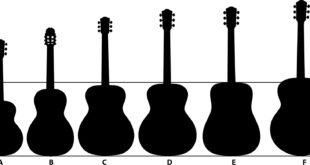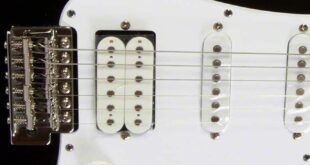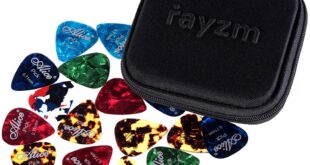A capo is an excellent technique to increase your musical creativity. Don’t let the guitar capo’s small size fool you: it’s the most inexpensive component of gear you can buy to change your performance significantly.
Because of the enormous potential for songwriters, musicians covering tunes, and anybody who wishes to create more openings as a guitarist, every musician should buy one of these pieces of equipment.
A capo can give chord work a distinct feel and texture by brightening and raising the tonality as needed. A capo can also assist singers or guitarists in changing the tone of a song and covering different vocal capabilities. Capos are useful for jamming in difficult acute or flat key combinations and transposing a song to a steeper angle while keeping the same chord patterns.
However, not all caps are created equal; there is a wide selection of designs to pick from to suit various budgets. Quality is important, which is why we’ve compiled a list of the top guitar capos to meet your needs. We encourage that almost everyone engages in one of the alternatives in this guide because the capo is a gig bag standard no matter what guitar you play.
Table of Contents
How does a guitar capo work?
A capo is a tool that clamps down over the fingerboard of the guitar at a specific fret. Capos reduce all of the strings at the very same time, thereby forming a new nut. All the “open” chords are now playing at higher frequencies than before the capo was applied. Capos can use elastic springs and even threaded screws.
To set it appropriately, put the capo before the chord, towards the tuning pegs, rather than right over the metal fret wire. People also employ a capo for reasons that are unrelated to vocal genres. The guitar produces a louder tone when a capo is placed on the neck, particularly high on the neck. It even could sound like a mandolin.
Sometimes all we want is for things to seem different, for a song to have a little more richness or personality. You can experiment with different tunings and chord voicings by learning how to utilize a capo; this has the potential to be fantastic.
The capo is imbalanced in its attachment to the guitar. Because the capo’s strain bends the strings, this can make the instrument sound terrible. It twists the strings a bit, but it only takes a little bend for the guitar to sound out of sync. Getting seamless and even fitting is the most critical factor in learning how to use a capo.
The capo must be placed evenly on the guitar. Its elastic tension will ‘shut’ the capo and fasten it to the guitar’s neck when you let go of the handle. It would help if you had the capo flat and balanced before releasing the handle. If you’re looking for presents for guitar players for any celebration, the capo is a great option; even if the guitarist already has one, having extras don’t harm anyone.
Choose the Best Guitar Capo for Acoustic Guitars
Shubb capo stands out from its competitors because it has a patented rubber finger that indicates how your index finger will be used to bar a chord. It is the unique design of the capo that helps you adjust the pressure. Adjusting the pressure will make it easy for you to use the guitar without hesitation and full confidence. In this way, it will keep the intonation correct.
The adjustable screw of the capo further contributes to the perfect and precise tuning of the guitar when you want to play at. While in position, just a few turns of the screw will give you a variety of frets with great tuning.
An issue that arises with this type of capo is that you will have to use two hands to put the capo in its place on the guitar, or else it will not adjust properly. It is a little fiddly. Therefore, you will have to use two hands, but with practice, you will learn how to place it on the guitar’s neck with one hand. So, if you do not mind using two hands while placing and adjusting the capo, then the Shubb S1 stainless steel guitar capo is for you.
The stainless-steel version of Shubb’s capo is more resistant to nicks and scratches, making it long-lasting. Being made in the USA, great craftsmanship is involved in making it look and feel good.
Pros:
- Low price
- High quality
- Accuracy when it comes to tuning and playing a variety of frets
Cons:
- Requires two hands to put on the neck or else, it is fiddly
- Might not be easy to use for some users.
Kyser has one of the most precise tunings, so much so- it’s hard to find it in any other capo. But just like other similar capos, you will require practice to know where the capo should be placed on the neck of the acoustic guitar for the most precise tuning that is according to your liking.
Keeping the beginners in mind, Kyser has designed this capo that is very easy for the users to use, but since it is a bit tight, it will require a good grip from you to get the desired results that you are looking for. The simple design allows the users to make quick and easy changes with just one hand thus, reducing their effort. The easy-to-use design makes Kyser’s quick-change capo one of the most popular capos available out there.
It is designed in a way that you can place it on the strings from the bass side. This prevents your hand from brooding about being restricted by the capo, making it easy for you to fret without disturbing the capo and disturbing the settings.
The feel and quality of Kyser’s quick-change capo make it look more costly than what it is priced at. It is strong and varnished in a way that gives a nice and slick look and feel.
Kyser is one of the cheapest options for capos available in the market. Even though the prices are low, Kyser does not compromise on quality or performance. It is one of the best performing capos, especially for beginners.
Pros:
- It is cheap
- High quality
- simple design making it easy to change with one hand
Cons:
- Spring can be stiff
- Difficult for some people to squeeze open
However, Donner DC-2’s performance is very much dependent on the type of guitar and its neck. If the size of the neck of the guitar is perfect and Donner DC-2’s capo can fit right onto it then, it will tune and work well on your guitar, making it one of the best choices for you.
Donner DC-2 also has a competitive advantage over others on this list when it comes to the ease and simplicity of using it. Placing and adjusting this capo with one hand is a piece of cake for the users, no matter if they are an expert or a beginner. The spring is not too tight, so not a lot of effort will be required to place it on the acoustic guitar’s neck. Despite all this, you must remain careful while using it because if the guitar is too chunky, you should be careful not to let the capo catch the guitar’s strings.
The build of Donner DC-2 is quite strong to the point that it feels fixed. No matter how much or how roughly you use it, it will not break. It is durable and long-lasting, so; you do not have to worry about breaking and regret wasting your money. Investing in Donner DC-2’s capo is a long-term investment due to its long-lasting built. However, recently, Donner’s tuning has received a few complaints because there is very little ability to adjust the tension. Because you cannot adjust the tension, it might not perform as well as you want on higher frets.
Pros:
- Strong built making it long-lasting
- Easy to use with one hand
- The spring is not tight.
Cons:
- Might not work well on all the guitars
- Not much ability to adjust the tension
The side near the screw has a lot of power, but the far side of the capo lacks the clamping power. Because of this, you will have to give it a lot of squeezes so that the far side capo can be adjusted properly. Keeping the pressure and effort required to adjust it aside is one of the best capos when it comes to tuning. It tunes well, and you have the ability to adjust tensions as well, so, even at higher frets, it will perform at its best.
Unlike quick capos, screw capos are difficult to use, but they tune better than quick capos. So, for good tuning, you might have to give up on the ease of using it. Even so, it is not that hard to use; you can use one hand to place it on the acoustic guitar’s neck and adjust it- it might require some practice at first. If you are a beginner, you will have to face a bit more difficulty, but you will become a pro at placing and adjusting it with practice. When using a higher fret, you will need your picking hand to help clamp the capo.
D’Addario’s capo is made up of moulded ABS thermoplastic. This means that it will need some effort for it to break at any time. The building is made up of very minimal parts and is constructed well. The company keeps the users in mind if in case they want to use it for a longer period without having to change it and splurge on money.
D’Addario’s capo can serve as one of the best capos if you lose your main one. Then, this one can be used as a great substitute. It is quite cheap and suitable for beginners or people looking for backup capos if someone steals their main one or breaks it.
Pros:
- One of the best at tuning
- Will not break
- Long-lasting
- Cheap
Cons:
- Requires effort and power to squeeze and adjust the capo
- Difficult to adjust if you are a beginner
A 6-string guitar provides accurate tuning and strong pressure to clamp down without producing any fret buzz. But a 12-string guitar will require greater pressure, clamping force, or, as some people recommended, better rubber padding.
On the other hand, the clamping force might be too strong for nylon string guitars, due to which it might go sharp in pitch. It’s hard to beat for the price you’re paying. However, the clamping force might be an issue for some users, but if you have a 6-string guitar, it’s going to be your new favorite.
Pros:
- Cheap
- Strong clamping force
- High build quality
Cons:
- A 12-string guitar might require extra clamping force, which this capo cannot provide.
Buying guide for best guitar capo for acoustic guitars
Capos are essential for guitars and have been around for the longest time. Even though they are relatively smaller and simpler to use, there are many things to consider before buying one since they can completely change your playing experience concerning the guitar’s tuning. Because it is not possible to check each capo on the market, here are a few things that you need to look for in a capo to ensure it’s the perfect fit for you and your acoustic guitar.
• Full Capo vs Partial Capo
Full capos are all used to do the same job: to shorten the strings across the fingerboard and allow one to sing in several keys. Most of the capos out there used are full capos. However, some individuals also use partial capos, which clamp fewer strings than full capos. These capos allow one to tune differently and give new resonances, fingering possibilities and voicings.
Both types of capos are great, depending on whether you’re looking for a more traditional approach or something which offers you a chance at new chord voicings.
• Fit and radius
Most capos come in 3 shapes: flat, curved or radius and these shapes greatly affect the type of performance the capo offers. Each guitar manufacturer chooses a fingerboard radius that suits their preference, which means that if the capo curvature does not align with that of the guitar, the strings might stretch out of tune. For this exact reason, it is first important to see the kind of radius which your guitar offers and then purchase a capo with similar curvature.
• Tone
The tone is another factor that is extremely important when purchasing a capo. The type of rubber used in a capo is what affects the tune of the sound. This means that when you use a softer rubber, your tune might die down slightly; however, this will not be the case if you use a capo with hard rubber. Also, with softer rubber, you can mute the strings with lesser force, which ensures more feasibility for you. It is also important to remember that on a 12-string, a capo with softer rubber oozes down a little, which stops the bottom four courses in a better manner than if we use a harder capo.
• Price
Capos, like everything, come at varying prices, but it is important to set a prior budget. In our opinion, any capo that costs over $80 is not worth it since it is unreasonable to spend such a huge sum for a capo. For this reason, you can buy a capo over the internet, which is cheap if it works for you while playing or otherwise you can get yourself something a bit pricier. It is essential to note that all capos do the same job, so investing more money is not worth it, especially if it is a larger sum.
• Weight
Capos come in different sizes, but we need to keep in mind that attaching heavy masses of metal with the guitar might not be the things we need for playing well. This might interfere with the resonance of your instrument; thus, using a lighter capo is always recommended. While using a small and compact capo is appreciated, it has more chances of being misplaced. For this reason, one needs to use capos with lesser weight since they allow for less visibility and are easier to carry while also being easier to attach.
• Force
Force is an extremely important element to look at when searching for a capo. There are various factors on which force depends. This includes the elastic, spring and screw clamping systems, which exert force in different levels and manners. This means you will need to choose a capo which can handle your string gauges and the height of your strings.
For this purpose, spring-powered capos work perfectly for standard light strings; however, when dealing with heavier strings or even a 12-string, you might deal with certain difficulties if you don’t choose a particular model designed for that purpose especially.
• Convenience
With capos, one thing that is to be kept in mind is their never-ending variability. This means that it is very easy to find capos, which might be very easy to attach and remove, while it is also very common to find capos which take a while to be attached. However, one should always go for a capo, which can be popped on and off within seconds, and this convenience and ease come at a cost.
If convenience is a preference for you, you might lean towards the spring capos, which are great to use but come with the disadvantage of weakening with time and pulling slightly sideways. Another kind of capos that can be used are screw clamps which allow you to screw the capo to the guitar. Although these are not the most convenient, like the Snap-On ones, they still ensure that your capo stays in place and allows for better clamping.
• Fashion
For some, fashion is a priority while using a capo. For this purpose, there are also degrees of fashion attached with using this equipment. For people who are fine with good quality material and willing to be inexpensive, aluminum capos are the best thing ever. Some use plastics, while some companies make wooden capos that give a rustic feel.
With so many kinds of capos out there to choose from and each with varying quality and edge to it, it is surely a task to find the right capo for your acoustic guitar, but if you keep the points mentioned above in your mind before looking to find your capo, you are sure to find one that matches your guitar just the way you want, giving you the best playing and singing experience you need.
Frequently Asked Questions
Do I need a capo for my acoustic guitar?
Only use a capo when the song calls for open strings. A capo brightens the sound of the guitar. In the key of C, for instance, you can play the chords without a capo. The other musician may play the chords in G with a capo at the 5th fret, making them sound like they’re in C.
How do I choose a guitar capo?
Ensure that the capo is tight enough to allow all open strings to ring properly but not so stiff that the strings are plucked sharply. Choose one capo that matches the fretboard’s curve and width. Fretboards on some guitars are quite curved, whereas fretboards on 12-string guitars are very broad.
Will capo damage my guitar?
A capo will not harm the guitar neck. When over-tightened to the neck, though, it might wear down the surface. This implies that you won’t be able to change the strain on your guitar’s capo if it’s too tight. And not only will this throw your guitar out of tune, but it will also wear down the finish on the guitar neck.
Should a beginner guitarist use a capo?
You can play more tunes with fewer chords when you use a capo. For many musicians, especially novices or primarily vocalists and want to complement their singing, one of the most significant advantages is that employing a capo enables you to perform more songs with fewer chords.
Are capos one size fits all?
Every capo limit how thin, wide, or vast of a neck it can support. String spacing is also a concern with partial capos. Only the Spider Capo and the Third Hand, both global partial capos, correct for string space, which tends to increase at upper frets.
What capo does ed Sheeran use?
Many of Ed Sheeran’s tracks feature a Dunlop Trigger Capo. You can use whichever capo you like, although trigger-style capos are the most convenient for switching songs.
Are capos cheating?
Yes, a capo is a sort of cheating if you’re performing to impress musically, as you’d be utilizing the support to bar a fret. However, it is merely one facet of playing the guitar. With a cap on, you may dazzle in other technical aspects.
When not in use, remove the capo from the instrument. When the capo is fastened on the neck, the strings are held down on the fingerboard, and extra strain is created on the neck and top of the guitar. The pressure of the strings on all acoustic instruments is destined to cause issues at some moment.
Final Verdict
As every guitarist will remind you, having the best capo will make your life so much easier. Countless tunes necessitate the use of this guitar attachment to be played correctly. You won’t be able to perform without a capo if you’re a folk performer.
Even the most advanced guitar capos are, at their core, simple mechanisms. In its most basic sense, it’s a clamp that raises the pitching of your guitar, equivalent to putting the nut or your finger on a higher fret on a guitar. Some players believe it is unethical. Others consider it a must-have in their gig bag. While the capo may be divisive, it can be valuable to your practice and composing routine.
 The Occasional Orchestra Learn About Everything Music!
The Occasional Orchestra Learn About Everything Music!








